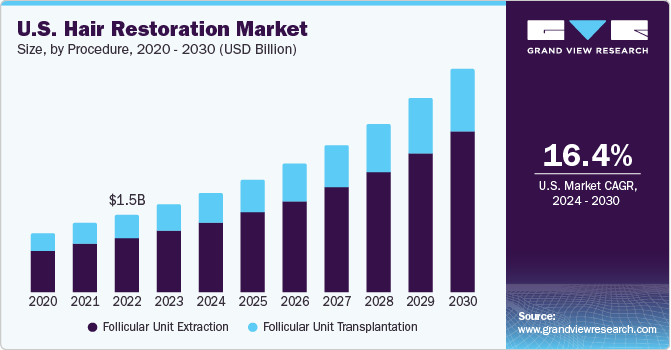Hair Restoration Industry Overview
The global hair restoration market size was estimated at USD 4.2 billion in 2020 and is expected to expand a compound annual growth rate (CAGR) of 15.4% from 2021 to 2028. The rising prevalence of androgenetic alopecia is the key factor driving the market. Lifestyle alterations, such as immoderate intake of tobacco and alcohol, and escalating stress indices are considered as strong triggers for the disease. Though the exact disease cause remains unknown, the genetic factors have been linked to several cases. Moreover, other factors such as the rise in disposable income and building emphasis on aesthetics are poised to drive the market.
The market is gaining momentum as the success rate of procedures like Follicular Unit Extraction (FUE) and Follicular Unit Transplantation (FUT) has increased and has proven to be effective options for hair restoration. Moreover, many hair experts now use a combination of these two procedures for significant aesthetic results. The major reason for hair restoration is in demand is that they have become less invasive in recent years.
Gather more insights about the market drivers, restraints and growth of the Global Hair Restoration market
Aging and hormonal anomalies have been listed as potential causative agents for alopecia. Thyroid imbalances or menopausal women may experience hair loss due to a drop in levels of estrogen. Androgen hormones like testosterone and Dehydroepiandrosterone (DHEA) are also major hormones, imbalances of which can dictate hair growth. An estimated 20 million Americans have some form of thyroid disease and up to 60% of those with thyroid disease are unaware of their condition. Furthermore, gender plays a key role in disease susceptibility. According to the American Hair Loss Association, it was stated that over 95% of loss of hair in men is caused due to androgenetic alopecia. In addition, a steady increase in consumer awareness toward alopecia therapeutic options is likely to positively impact the market in the future.
As stated by the International Society of Hair Restoration Surgery, in 2019, around 735,312 surgical hair restoration procedures were carried out globally and around 681,964 patients opted for the same. Out of this 84.2% of the patients were male and 15.8% were females. The number of males opting for hair transplants has increased as many of them had a genetic sensitivity to a byproduct of testosterone called Dihydrotestosterone (DHT).

Social media alone is playing a very crucial role in promoting hair restoration procedures. Forbes article of 2019 states that 5% of the influencers who offer product or service recommendations drive 45% of social influence, this will further strengthen the market. Technological advancement such as investigational stem cell therapy and Light or laser therapy is also boosting the market growth. According to NCBI, in 2017, research was carried out in order to know the primary outcomes of using stem cell therapy for hair restoration treatments. According to this research, the use of stem cells can prove to be very promising to prevent hair loss. The results also showed a 29% increase in hair density 23 weeks after the last treatment.
However, elective procedures like hair restoration were one of the worst affected at the beginning of the COVID-19 pandemic. Surgical practices across the world were halted. With no patient visits and declining revenues, several dermatology clinics had to undergo unforeseen challenges. With the ease of lockdowns in most of the countries, hair restoration services are also reopening, however, following strict protocols has added to the expenses for several hair experts. International Society of Hair Restoration Surgery has laid down strict protocols in order to resume clinics and provide infection control procedures. The footfall and the appointments per day are still low. Hair transplant is a very time-consuming procedure and the process has to be done with more extreme care and caution due to the pandemic, therefore resulting in low patient visitations.
Browse through Grand View Research's Healthcare Industry Related Reports
Platelet Rich Plasma Market - The global platelet rich plasma market size was valued at USD 546.6 million in 2021 and is expected to expand at a compound annual growth rate (CAGR) of 15.11% from 2022 to 2030.
Alopecia Market - The global alopecia market size was valued at USD 7.6 billion in 2020 and is expected to expand at a compound annual growth rate (CAGR) of 8.1% from 2021 to 2028.
Hair Restoration Industry Segmentation
Grand View Research has segmented the global hair restoration market on the basis of procedure, therapy, and region:
Hair Restoration Procedure Outlook (Revenue, USD Million, 2016 - 2028)
- Follicular Unit Extraction
- Follicular Unit Transplantation
Hair Restoration Therapy Outlook (Revenue, USD Million, 2016 - 2028)
- Low-Level Laser Therapy (LLLT)
- Stem Cell hair restoration
- Platelet-Rich Plasma
Hair Restoration Regional Outlook (Revenue, USD Million, 2016 - 2028)
- North America
- Europe
- Asia Pacific
- Latin America
- MEA
Market Share Insights:
February 2018: Venus Concept announced the acquisition of NeoGraft Solutions' hair restoration business ("NeoGraft").
Key Companies profiled:
Some prominent players in the global Hair Restoration Industry include
- Venus concept
- Bernstein Medical
- Bosley
- The Harley Street Clinic
- Advanced hair studio
- Milla Marie
- Lexington Intl., LLC
- Cole Hair Transplant Group
Order a free sample PDF of the Hair Restoration Market Intelligence Study, published by Grand View Research.


No comments:
Post a Comment